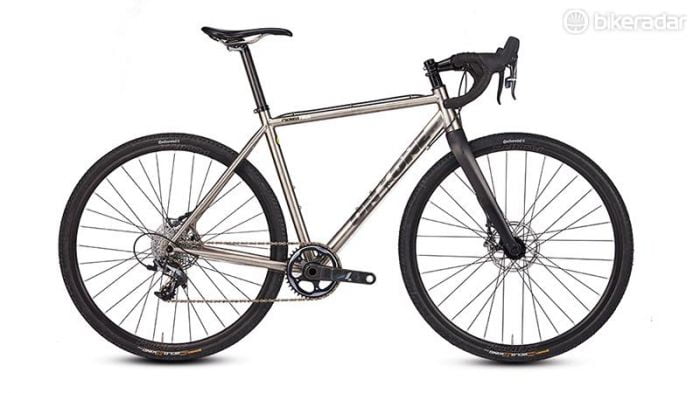
On-One is a name well known to riders who dabble in cycling’s grimier disciplines – though most roadies will be more familiar with sister marque Planet X. The company’s cyclocross models are shared between the two brands, and the Pickenflick is a proper racer built around a titanium chassis.
Being built for competition doesn’t mean leisure riders should ignore it though, because if there’s one thing we’ve learnt from the explosion in all-road bikes (or ‘gravel grinders’, if you must), it’s that there are real benefits to be found in blurring the lines.
The Pickenflick’s 3Al/2.5V titanium frame is a stout thing with chunky stays and a tapered head tube that blends neatly with a butch looking full carbon fork. Cabling is external, and since it’s a ‘cross bike, the rear brake hose runs above the top tube to make shouldering easier.
What really sets the Pickenflick apart is how it’s equipped. The keen eyed will note that the left brake lever is just that – there’s no shifter paddle, because there’s only one chainring up front and hence no front derailleur, giving 1×11-speed gearing.
Why? A ‘one-by’ arrangement simply has less to go wrong: with a clutch on the rear derailleur and ‘X-Sync’ chainring technology that uses tall, squared-off teeth in a narrow/wide alternating pattern, chain drops are a non-issue, and of course you’re relieved of front shifting duties too. All this will be old hat to mountain bikers, but it’s one of many technologies that’s proving useful away from the trails.
On-One is a mountain bike brand first and foremost though, and the Pickenflick’s slightly unconventional geometry seems to reflect this. In recent years those designing for the rough stuff have been exploring the handling advantages of ever-shorter stems and wider bars, with added top tube length to preserve the reach.
While our small Pickenflick had relatively standard 42cm bars, its 555mm top tube sounded on the face of it to be exceptionally long. In reality, with a fairly slack seat angle of 73 degrees and an 80mm stem, we didn’t feel at all stretched. We’d have preferred an inline seatpost though, as the laid back geometry had us sliding the saddle forward to its front limit.

The front end is slacker than on most road bikes too, and the sum of all these details is a bike that rides brilliantly off the tarmac, with accurate yet forgiving handling at all speeds and whatever the incline. We took the Pickenflick to Salisbury Plain to try out some gravel, and it acquitted itself marvellously.
You might expect 35mm ‘cross tyres and a metal frame to feel heavy, but this is light for a disc bike – and it shows. It’s also impressively stiff under power, responding in a most satisfying manner to a good kick of the pedals. The big seat tube and 31.6mm post don’t offer a lot of give, but with decent volume tyres (and room to go bigger), comfort isn’t really a concern.
The SRAM hydraulic brakes bite less hard than their Shimano counterparts, but feel nice and progressive. Some front disc rub was evident out of the saddle, which we put down to a minute amount of flex in the fork.
The only catch to the Pickenflick is that it’s a very focused machine. Because at heart it’s a race bike, there’s no provision for everyday practicalities like mudguards, and while the 1×11 setup offers a decent range, it can feel slightly lacking on fast paved descents or prolonged steep climbs. There’s a cheaper version of the bike with standard gearing if you prefer though – and in any case, the Pickenflick is a tremendously capable ride that with a change of tyres could rival plenty of pure road machines.
[“source-bikeradar”]





